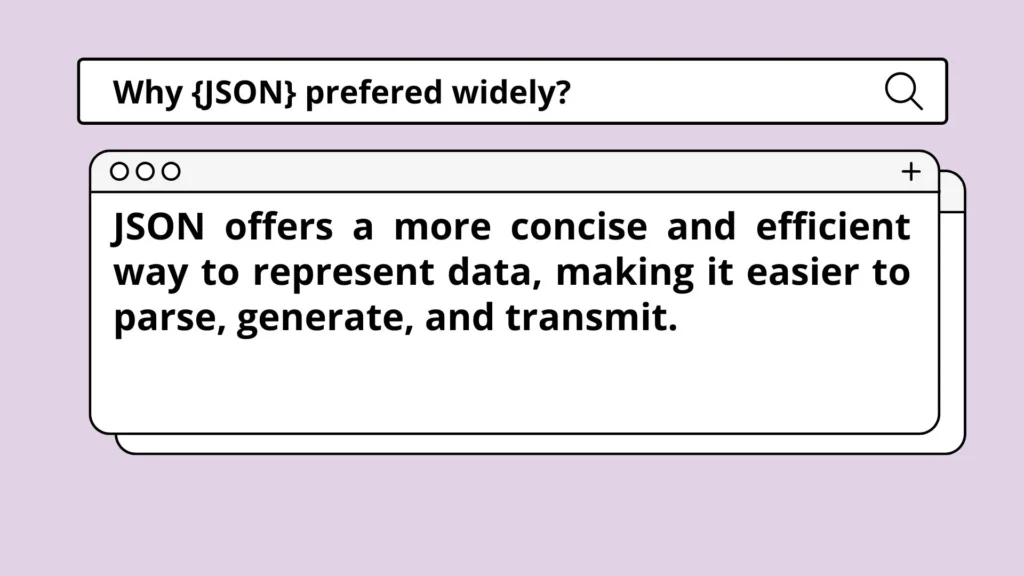Why is JSON preferred widely?
Learn JSON with examples

In this blog we will look into
JSON data format
JSON (JavaScript Object Notation) has firmly established itself as the dominant data format in the digital landscape. Boasting a range of advantages over traditional formats like XML and CSV, JSON has become the go-to choice for data exchange, storage, and transmission.
Rise of JSON
The rise of JSON can be attributed to its simplicity, readability, and widespread adoption across various industries and applications. Unlike XML’s verbose and complex structure, JSON offers a more concise and efficient way to represent data, making it easier to parse, generate, and transmit. This lightweight format has become the preferred choice for data exchange in web applications, APIs, and mobile development. Its compatibility with JavaScript, a cornerstone of modern web development, has further fueled its popularity. JSON’s flexibility allows for easy representation of complex data structures, including nested objects and arrays, without sacrificing clarity. Moreover, JSON’s language-agnostic nature has contributed to its universal appeal. Developers working with different programming languages can easily integrate JSON into their projects, fostering interoperability and streamlining cross-platform development. This versatility has led to the creation of numerous JSON-based tools, libraries, and frameworks, further solidifying its position as a essential component in the modern software ecosystem. Moreover, the ubiquity of JavaScript, the language in which JSON was born, has further propelled its popularity. JSON’s seamless integration with JavaScript has made it the preferred format for web-based applications, APIs, and data exchange between client and server.
JSON took over XML and CSV
Compared to CSV, JSON provides a more structured and hierarchical approach to data representation, allowing for the capture of complex relationships and nested information. This flexibility has made JSON the preferred choice for modern data-driven applications and the exchange of rich, structured data.
The statistics speak for themselves – according to industry reports, JSON has surpassed XML as the most commonly used data format, with a significant majority of web services and APIs now supporting JSON as their primary data exchange mechanism. This shift towards JSON is not without reason. Its lightweight structure and ease of use make it more efficient for data transmission, resulting in faster load times and improved performance for web applications.
Developers appreciate JSON’s simplicity and readability, which streamlines the coding process and reduces the likelihood of errors. Furthermore, JSON’s compatibility with JavaScript, the dominant language for front-end web development, has cemented its position as the go-to choice for modern web applications. The widespread adoption of JSON has also led to the development of robust tools and libraries across various programming languages, further enhancing its versatility and appeal. As more organizations recognize the benefits of JSON, we’re seeing a ripple effect throughout the tech industry, with many legacy systems being updated to support JSON integration. This trend is likely to continue, solidifying JSON’s position as the de facto standard for data interchange in the foreseeable future.
Dominance of JSON
As the digital landscape continues to evolve, the dominance of JSON is poised to grow even stronger, solidifying its position as the go-to data format for the foreseeable future. This trend is driven by several key factors that make JSON indispensable in modern technology ecosystems. Firstly, its simplicity and human-readability make it accessible to both developers and non-technical stakeholders, fostering better collaboration across teams. Additionally, JSON’s lightweight nature contributes to faster data transfer and processing, crucial in an era where speed and efficiency are paramount. Furthermore, JSON’s flexibility allows it to seamlessly integrate with a wide array of programming languages and frameworks, making it an ideal choice for cross-platform development and microservices architectures.
As the Internet of Things (IoT) expands, JSON’s ability to represent complex data structures in a compact format positions it perfectly for handling the vast amounts of data generated by connected devices. The widespread adoption of JSON in cloud computing and serverless architectures further cements its importance in modern software development. As these technologies continue to gain traction, JSON’s role in facilitating smooth data exchange between disparate systems will only become more critical.